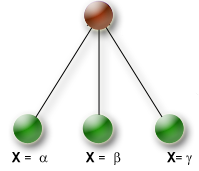assign_var

function assign_var(varsel:function or string,valsel:function or string,variables:set of cpvar) : cpbranching
function assign_var(varsel:function or string,valsel:function or string,variables:array(range) of cpvar) : cpbranching
function assign_var(varsel:function or string,valsel:function or string,variables:cpvarlist) : cpbranching
function assign_var(varsel:function or string,valsel:function or string) : cpbranching
|
varsel
|
name of the variable selector (pre-defined constant, name of user-defined function or reference to user-defined function)
|
|
valsel
|
name of the value selector (pre-defined constant, name of user-defined function or reference to user-defined function)
|
|
variables
|
list of variables to branch on
|
model "User branching"
uses "kalis"
parameters
ALG=1
end-parameters
forward function varchoice(Vars: cpvarlist): integer
forward function varchoice2(Vars: cpvarlist): integer
forward function valchoice(x: cpvar): integer
forward function valchoice2(x: cpvar): integer
setparam("KALIS_DEFAULT_LB", 0);
setparam("KALIS_DEFAULT_UB", 20)
declarations
R = 1..10
y: array(R) of cpvar
C: array(R) of integer
Strategy: array(range) of cpbranching
end-declarations
C:: [4, 7, 2, 6, 9, 0,-1, 3, 8,-2]
all_different(y)
forall(i in R | isodd(i)) y(i) >= y(i+1) + 1
y(4) + y(1) = 13; y(8) <= 15; y(7) <> 5
! Definition of user branching strategies:
Strategy(1):= assign_and_forbid(->varchoice2, ->valchoice, y)
Strategy(2):= assign_var(->varchoice, ->valchoice, y)
Strategy(3):= split_domain(->varchoice, ->valchoice2, y, true, 2)
Strategy(4):= split_domain(->varchoice2, ->valchoice, y, false, 5)
! Select a branching strategy
cp_set_branching(Strategy(ALG))
if cp_find_next_sol then
forall(i in R) write(getsol(y(i)), " ")
writeln
end-if
!---------------------------------------------------------------
! **** Variable choice ****
! **** Choose variable with largest degree + smallest domain
function varchoice(Vars: cpvarlist): integer
declarations
Vset,Iset: set of integer
end-declarations
! Get the number of elements of "Vars"
listsize:= getsize(Vars)
! Set on uninstantiated variables
forall(i in 1..listsize)
if not is_fixed(getvar(Vars,i)) then Vset+= {i}; end-if
if Vset={} then
returned:= 0
else
! Get the variables with max. degree
dmax:= max(i in Vset) getdegree(getvar(Vars,i))
forall(i in Vset)
if getdegree(getvar(Vars,i)) = dmax then Iset+= {i}; end-if
dsize:= MAX_INT
! Choose var. with smallest domain among those indexed by 'Iset'
forall(i in Iset)
if getsize(getvar(Vars,i)) < dsize then
returned:= i
dsize:= getsize(getvar(Vars,i))
end-if
end-if
writeln(returned)
end-function
! **** Choose variable y(i) with smallest value of C(i)
function varchoice2(Vars: cpvarlist): integer
declarations
Vset,Iset: set of integer
VarInd: array(Iset) of integer
end-declarations
! Set on uninstantiated variables
listsize:= getsize(Vars)
forall(i in 1..listsize)
if not is_fixed(getvar(Vars,i)) then Vset+= {i}; end-if
if getsize(Vset)=0 then
returned:= 0
else
! Establish a correspondence of indices between 'Vars' and 'y'
forall(i in R)
forall(j in Vset)
if is_same(getvar(Vars,j), y(i)) then
VarInd(i):= j
Vset -= {j}
break 1
end-if
! Choose the variable
imin:= min(i in Iset) i; cmin:= C(imin)
forall(i in Iset)
if C(i) < cmin then
imin:= i; cmin:= C(i)
end-if
returned:= VarInd(imin)
end-if
writeln(imin, " ", returned)
end-function
!---------------------------------------------------------------
! *** Value choice ****
! **** Choose the next value one third larger than lower bound
! (Strategy may be used with any branching scheme since it
! makes sure that the chosen value lies in the domain)
function valchoice(x: cpvar): integer
! returned:= getlb(x)
returned:= getnext(x, getlb(x) + round((getub(x)-getlb(x))/3))
writeln("Value: ", returned, " ", contains(x,returned),
" x: ", x)
end-function
! **** Split the domain into lower third and upper two thirds
! (Strategy to be used only with 'split_domain' branching since
! the chosen value may not be in the domain)
function valchoice2(x: cpvar): integer
returned:= getlb(x) + round((getub(x)-getlb(x))/3)
writeln("Value: ", returned, " x: ", x)
end-function
end-model
© 2001-2024 Fair Isaac Corporation. All rights reserved. This documentation is the property of Fair Isaac Corporation (“FICO”). Receipt or possession of this documentation does not convey rights to disclose, reproduce, make derivative works, use, or allow others to use it except solely for internal evaluation purposes to determine whether to purchase a license to the software described in this documentation, or as otherwise set forth in a written software license agreement between you and FICO (or a FICO affiliate). Use of this documentation and the software described in it must conform strictly to the foregoing permitted uses, and no other use is permitted.

